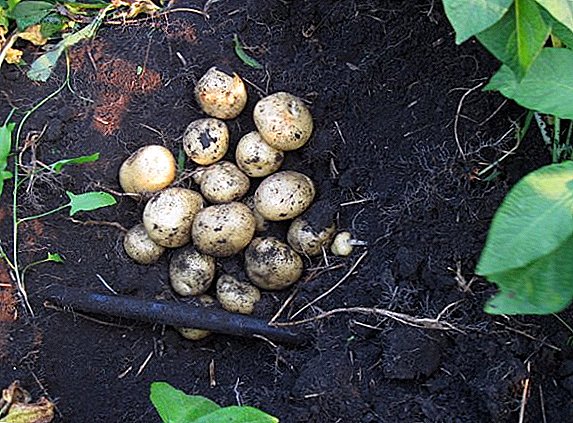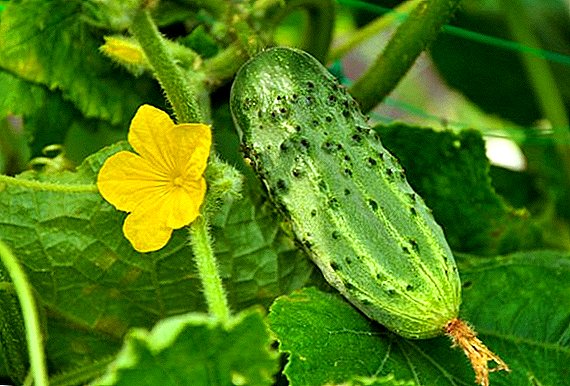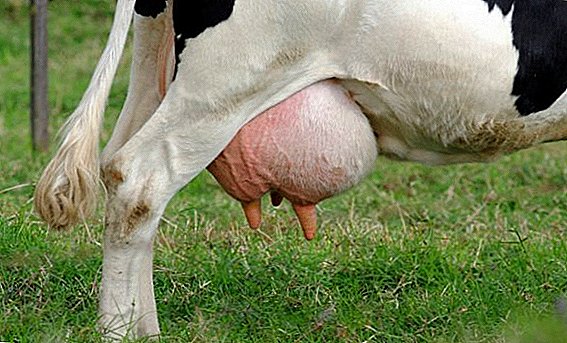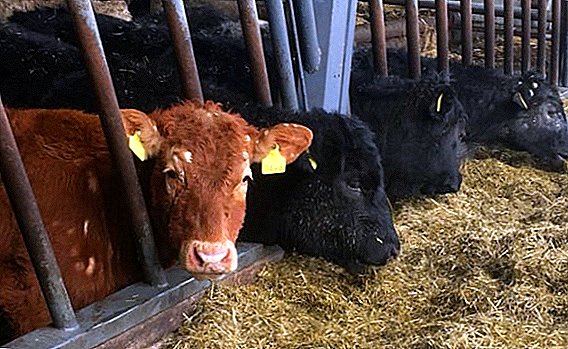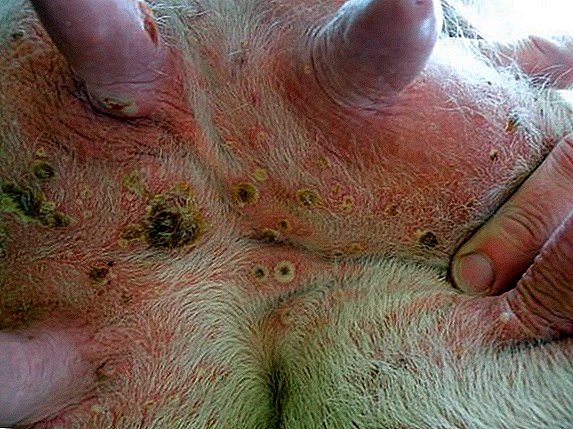 Cowpox is accompanied by specific rashes on the udder, muzzle, mucous membranes of the nostrils and the mouth of the animal. The disease is very dangerous, they can become infected not only with goats, sheep and horses living in the yard, but also people. The virus spreads by contact, airborne droplets and fecal-oral routes. How to recognize and treat a disease, whether a sick cow's milk is suitable for consumption, and whether there are ways to protect it from infection - read about it later in the article.
Cowpox is accompanied by specific rashes on the udder, muzzle, mucous membranes of the nostrils and the mouth of the animal. The disease is very dangerous, they can become infected not only with goats, sheep and horses living in the yard, but also people. The virus spreads by contact, airborne droplets and fecal-oral routes. How to recognize and treat a disease, whether a sick cow's milk is suitable for consumption, and whether there are ways to protect it from infection - read about it later in the article.
Pathogen, sources and routes of infection
The occurrence of smallpox in cows is triggered by coworthopoxvirus virus, which has its own DNA, as well as its vaccine strains. The pathogen is characterized by:
- complex structure;
- propensity for intensive reproduction in epithelial cells;
- highly resistant to the environment.
The best breeds of cows include such as: Dutch, Sychevskaya, Belgian blue, Hereford, Simmental, Dutch, Holstein and Ayrshire.
When it enters the subcutaneous layers, the virus is released from the outer shell, and its DNA, with the assistance of cellular systems, begins to actively produce its copies. As a result of this replication, the synthesis of protein substances of the exfoliated outer shell occurs. When a viral infection prevails in the composition of the cell, a destruction mechanism is triggered in its membrane and nucleus.  The causative agent of the virus Coworthopoxvirus Thus, particles of infectious material spread in the epithelium, capturing new areas. These processes are accompanied by a pronounced symptomatology of the disease.
The causative agent of the virus Coworthopoxvirus Thus, particles of infectious material spread in the epithelium, capturing new areas. These processes are accompanied by a pronounced symptomatology of the disease.
Pathogenic microorganisms do not lose their activity even at low temperatures. The virus can multiply for about one and a half years at +4 ° С, and its DNA will not lose its replication abilities at +20 ° С for 2 months. If the thermometer rises to + 50-60 ° С, the virus will die in 10 minutes.
Did you know? When Catherine II learned about smallpox vaccinations in Europe, she invited the English doctor Thomas Dimsdale to Russia and asked for her to be vaccinated first. The peasant boy Alexander Markov, a peasant boy who had already had smallpox, became a material donor. For this service, he was subsequently promoted to a noble rank with the name Markov-Ospenny, and his coat of arms showed a hand with visible mature pock.
Boiling up the pathogen can kill much faster - in this case, its death will occur 2 minutes after the seething key appears on the surface of the water. In direct sunlight, Coworthopoxvirus retains its vitality for 4 hours.  Healthy livestock can become infected with smallpox not only from the virus carrier, but also from its secretions from the mouth and nose, as well as upon contact with dried pox crusts that exfoliate from the affected areas. Carriers of infection are:
Healthy livestock can become infected with smallpox not only from the virus carrier, but also from its secretions from the mouth and nose, as well as upon contact with dried pox crusts that exfoliate from the affected areas. Carriers of infection are:
- sick animals (the disease is transmitted regardless of their species classification);
- mosquitoes and fleas;
- rodents;
- people;
- water;
- feed;
- litter;
- inventory;
- absolutely all secrets secreted by living organisms.
Learn more about how to treat infectious diseases such as: chlamydia, bluetang, leptospirosis, malignant fever, anaplasmosis, parainfluenza-3, and actinomycosis.
Veterinarians note that the risk of having smallpox in a hundredfold increase in animals with:
- microtraumas, abrasions and cracks on the udder;
- immunocompromised;
- impaired metabolism;
- avitaminosis;
- exhaustion;
- and also in cows during the period of recovery after illness and calving;
- in young animals (especially in the early stages of development, when the body's defenses are still at the stage of formation).
 Cows with emaciation have a greater risk of getting smallpox
Cows with emaciation have a greater risk of getting smallpoxSymptoms and course of the disease
Depending on the method of penetration of the viral agent and the degree of its virulence, the course of the disease and its severity are determined. The immune system of an infected cow also has a considerable effect on these processes.
Obvious signs of smallpox begin to appear only 9 days after the virus is localized in epithelial tissues. In rare cases, the incubation period may be reduced to 3 days.
Farmers should read about how to choose a good dairy cow, what are the structural features of the udder of the cow, and also consider the characteristics of some milk coolers.
Cowpox begins with prodromal signs:
- depression;
- lethargy;
- lack of appetite;
- decrease in milk productivity (milk loss can stop altogether, and the cow will start pox mastitis);
- a slight increase in body temperature (up to + 40-41 ° C);
- swelling and hardening of the affected skin and mucous membranes;
- udder soreness that manifests itself in the process of milking (the cow does not allow the milkmaid);
- anxiety;
- difficulty in walking (the animal puts his legs wide to avoid touching them with the udder);
- the appearance of reddened roseol, which after 2-3 days transform into nodules-papules compacted and elevated above the skin surface (in cattle females, the udder, nipples, head, neck, back, thighs are most often affected, and in the male scrotum, nostrils, mouth and lips);
- the formation of red spots of vesicles on the spot, filled with transparent lymph, which contains a virus (usually bubbles appear on the 2nd day of the disease);
- suppuration of blistering skin lesions, with the result that they turn into rounded or oval pustules with a clear red edge and a recess in the center (an adult of such purulent foci may have more than 20 pieces);
- deep soft tissue necrosis;
- merging of adjacent nodules and formation of bleeding cracks in their place;
- desquamation of drying crusts that formed after 12 days on purulent pustules.
 Cow depression is one of the signs of smallpox
Cow depression is one of the signs of smallpoxOspins do not appear simultaneously, but over several days. Their maturation lasts about 2 weeks. If the disease proceeds in an uncomplicated form, recovery occurs in 20-28 days. In the case of aggravating factors and the build-up of side infections, the disease can torment the cattle for 2 months. The young livestock often develop complications in the form of bronchopneumonia and gastroenteritis.
Important! Cow pox caused by vaccinia virus is easier and less prolonged, but often affects all dairy individuals in the herd. Ospins appear in the places of primary lesion and look more convex than during viral infection, since the pathological process covers relatively more superficial layers of the epidermis.
Cowpox can occur in different forms:
- acute;
- subacute;
- chronic.

Diagnostics
In veterinary practice, confirmation of the clinical symptoms of vaccinia is carried out on the basis of laboratory and postmortem studies. To carry them out, it is important to select bioprobes from inflamed blistering formations on the skin. For this purpose, the following manipulations are carried out:
- Cut the festering pustules and take a swab from it.
- The stained biomaterial is stained according to the Morozov method.
- Check the drug for the presence of alimentary bodies.
 In the process of diagnosis, it is important to take into account the epizootic environment in the farm and the region. In the case when the cattle could not be cured and she was prematurely sent to the slaughterhouse, you should pay attention to the internal changes in meat carcasses. When opening them are obvious:
In the process of diagnosis, it is important to take into account the epizootic environment in the farm and the region. In the case when the cattle could not be cured and she was prematurely sent to the slaughterhouse, you should pay attention to the internal changes in meat carcasses. When opening them are obvious:- purulent foci of inflammation close to pockmarks;
- erosion on the tongue (their occurrence is due to rejection of the mucous membranes of the oral cavity);
- enlarged lymph nodes.
Important! The cowpox virus is very sensitive to ultrasound.
How to treat smallpox in a cow on the udder
Despite the medical progress, today there is no cure for smallpox rash. Its treatment consists in combating symptomatic symptoms, preventing possible complications and removing pathogenetic effects. However, in addition to antibiotic drugs, therapeutic measures include many other activities. Consider them in more detail. 
General recommendations
When a smallpox cow appears on your farm, it must be isolated from other animals without fail. To do this, it is important to first prepare a separate room for healthy neighbors. They will also need personal feeders, drinkers and cleaning equipment.
It will probably be useful for you to learn how to properly make drinkers for cows with your own hands.
In order to reduce the vital activity of the causative agent of smallpox, experts advise starting a therapeutic course with disinfecting the barn and all the utensils in it:
- First you need to remove the litter, manure and the remnants of feed from the feeders from the floor. All this is collected in separate packages and in order to avoid contamination of others disposed of in remote locations.
- After that, a hose is washed out of the hose under strong pressure of warm water, paying particular attention to contaminated sites, gaps and other hard-to-reach places. If necessary, use detergents and brushes.
- When the water in the room dries out (this should occur naturally), the walls and floors are fired using a blowtorch, holding the unit for a couple of minutes. The method is relevant for wooden and stone surfaces. Metal structures are treated with chemical disinfectants: 3% solution of chloramine (the virus will die in an hour) or carbolic acid (the expected effect will come in 2 hours). Many owners combine roasting with subsequent chemical processing. After the dry walls, it is desirable to whiten with hydrated lime. Disinfection measures will be required every 5 days after the next outbreak of the disease.
- Do not forget to disinfect all feeders and drinkers, as well as shovels, forks. In this case, it is desirable to scald them.
 To reduce the vital activity of the causative agent of smallpox, we disinfect the barn.
To reduce the vital activity of the causative agent of smallpox, we disinfect the barn.In the disinfected dry room, the floor is covered with a 10-cm layer of fresh straw, peat or sawdust. The litter is recommended to be changed every day, removing cow dung. Do not allow horned wards to trample on their own excrement, and even more so go to it, touching the udder.
Important! After the transfer of smallpox in cows, tissue-humoral post-infectious immunity is preserved for life.
For the health of cows and bulls, it is important that the barn has an appropriate microclimate:
- temperature regime - + 5-15 ° C;
- humidity - 60-70%;
- air exchange - per centner of live weight 17 cu. m / h (to achieve these indicators requires regular ventilation of the barn);
- air circulation rate - 0.5 m / s;
- carbon dioxide concentration - 0.25%, ammonia - 20 mg / cu. m
 In addition, a sick animal is important to provide nutrition, which will contribute to a strong immunity. In the trough should get only fresh and quality food.
In addition, a sick animal is important to provide nutrition, which will contribute to a strong immunity. In the trough should get only fresh and quality food.Many breeders, especially for their horned wards, sow plots with wicker, alfalfa or clover, and in order for the cattle to get all the necessary vitamins and minerals, they feed it with corn silage, fodder, brewer's grain, bran, grain-feed mixtures and premixes.
Important! Virus provoking smallpox in blood-sucking insects can persist for 100 days.
If the virus is localized on the mucous membranes of the oral cavity, provide cattle with liquid or semi-liquid fodder for the duration of the illness. During the disease, it is desirable to transfer the animal to a juicy feed. It is especially useful to give infected individuals garlic greens and elderberry branches.
In smallpox cows, it is important to produce milk every day. Be prepared for the fact that this process will be painful for you and for the animal. In extreme cases, veterinarians resort to a dairy catheter.  During the period of illness, the import and export of new livestock is prohibited. Disinfection barriers must be installed on the farm. All restrictive measures last for 3 weeks since the last recovery.
During the period of illness, the import and export of new livestock is prohibited. Disinfection barriers must be installed on the farm. All restrictive measures last for 3 weeks since the last recovery.
Read about the causes of blood in the milk of a cow.
Antibiotics, ointments and other drugs
Smallpox virus is specific, so the effectiveness of the fight against it can manifest itself using the following list of medications:
- An alcohol solution of iodine or chloramine (at a concentration of 3%), as well as Burov's liquid, is used as an antiseptic for burning new ulcers. The number of applications depends on the intensity of the pox rash.
- Syntomycin, streptomycin, boric or zinc ointments are recommended for the local treatment of inflamed skin lesions. Their action is aimed at accelerating the regeneration of the skin. Apply at least 3 times a day.
- Antibiotic therapy is prescribed by a veterinarian in cases where the animal has a weak immune system and suffers from beriberi, as well as with the development of serious complications (drugs and dosages depend on the specific course of the disease).
- For washing pockouts (this procedure is mandatory before each milking), experienced livestock breeders use infusions of sorrel or elderberry foliage. A more effective tool is considered to be gadgets from the same decoctions.

Can I drink milk
To support the strength of your health, a person, like any other living creature, should eat only high-quality products. If they are obtained from sources of viral infection, then they are no longer relevant.
Important! Strongly recommended for use in the treatment of smallpox eruptions moisturizers. They soften the surface of the ulcers and thus contribute to the active reproduction of virus-infected fluids.
Milk from smallpox cow is not the best way in its chemical composition and contains a viral infection. According to experts, it can be destroyed by boiling for five minutes or half an hour pasteurisation at a temperature of 85 ° C.
Given the stability of the smallpox pathogen and its mutational transformations, experts do not recommend drinking sick cow's milk. It is better to let it go for business needs. It is important to take into account the methods of treatment of the animal. If it came to antibiotic therapy, the cow product contains residual drugs.  According to the doctor of medical sciences, head of the laboratory for biosafety and analysis of nutrimikrobioma of the Research Institute of Nutrition of the RAMS Svetlana Sheveleva, instantaneous reactions to such milk are found only in the case of allergic reactions to penicillin, streptomycin, chloramphenicol.
According to the doctor of medical sciences, head of the laboratory for biosafety and analysis of nutrimikrobioma of the Research Institute of Nutrition of the RAMS Svetlana Sheveleva, instantaneous reactions to such milk are found only in the case of allergic reactions to penicillin, streptomycin, chloramphenicol.
Did you know? In memory of Dr. Edward Jenner, who first discovered the methods of fighting smallpox, and his vaccinations, at the suggestion of Louis Pasteur, the vaccination materials were called "vaccines" from the Latin word "vacca", which translated means "cow."
However, if we drink milk every day with a residual amount of antibiotics that exceed permissible norms, the body becomes accustomed to these substances, as a result of which its resistant functions are destroyed. 
Prevention and vaccine against smallpox cattle
Most often, smallpox in cows is observed in the autumn and winter seasons. In order to avoid viral infection, veterinarians recommend:
- Starting in August to begin prophylactic disinfection of the udder. This is done with the help of any antiseptic ointments that treat cow nipples before each milking.
- Strictly comply with sanitary and hygienic rules - before milking, wash the udder thoroughly with warm water, after wiping it with a clean towel. After milking, wipe the udder and nipples with a disinfecting cream. The clothes in which you milk the cow must be clean and must not be taken home.
- Periodically disinfect pasture and livestock sites.
- When importing new livestock, as well as fodder, equipment, it is initially to find out about the epizootic situation of the place from which it is planned to arrive. Such animals should be kept for a month in quarantine conditions with regular inspection.
- If we are talking about farm production, all staff must undergo compulsory vaccination. After being vaccinated for two weeks, the worker should not be in contact with animals.
- With the threat of infection for preventive purposes vaccinate all livestock.
- Regularly, once every 5 days, in the room to disinfect with chloramine, including inventory and utensils.
 My udder with warm water before milking Despite the fact that there is no special treatment for smallpox in cows, it is important to notice the first signs of the disease as soon as possible. Do not ignore the help of a veterinarian: the sooner you see a specialist, the sooner you begin to fight the virus, which is important for the overall condition of the horned ward.
My udder with warm water before milking Despite the fact that there is no special treatment for smallpox in cows, it is important to notice the first signs of the disease as soon as possible. Do not ignore the help of a veterinarian: the sooner you see a specialist, the sooner you begin to fight the virus, which is important for the overall condition of the horned ward.

